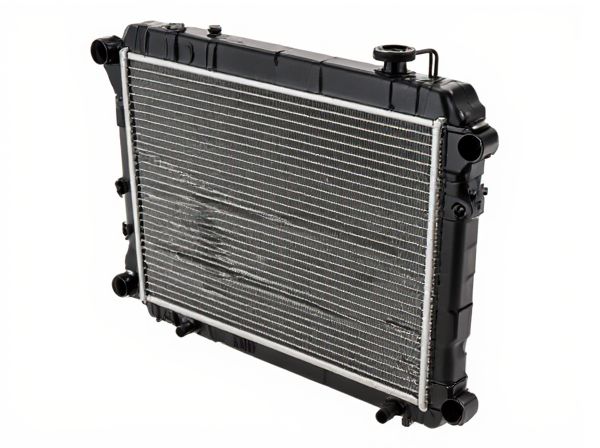
Photo illustration: High-Fin Density vs Low-Fin Density Radiator
High-fin density radiators improve heat dissipation by increasing the surface area, making them ideal for environments requiring efficient cooling. Low-fin density radiators allow better airflow with less resistance, suitable for quieter operation or systems with limited fan power. Your choice depends on balancing thermal performance with airflow needs to optimize cooling efficiency.
Table of Comparison
| Feature | High-Fin Density Radiator | Low-Fin Density Radiator |
|---|---|---|
| Fin Count per Inch | More than 18 fins/inch | Less than 12 fins/inch |
| Cooling Efficiency | Higher heat dissipation | Moderate heat dissipation |
| Airflow Resistance | Increased airflow restriction | Lower airflow restriction |
| Durability | Potential clogging risk | Better debris tolerance |
| Ideal Use | High-performance vehicles, hot climates | Standard vehicles, dusty or debris-prone environments |
| Maintenance | Requires frequent cleaning | Less frequent cleaning needed |
Understanding Fin Density in Radiators
High-fin density radiators feature a greater number of fins per inch, enhancing heat dissipation by increasing the surface area in contact with air, which improves cooling efficiency. Low-fin density radiators have fewer fins per inch, allowing better airflow and reduced resistance, making them ideal for systems with limited fan power or airflow. Understanding fin density helps optimize radiator performance by balancing heat transfer capabilities with airflow characteristics to meet specific cooling requirements.
What is High-Fin Density Radiator?
High-Fin Density Radiators feature a greater number of fins per inch, enhancing heat dissipation by increasing the surface area exposed to airflow. These radiators improve cooling efficiency in high-performance applications where effective thermal management is crucial. However, their dense fin design may restrict airflow, requiring powerful fans to maintain optimal cooling.
What is Low-Fin Density Radiator?
A low-fin density radiator features fewer fins per inch, typically ranging between 8 to 12 fins, allowing for better airflow and easier cleaning compared to high-fin density radiators. This design enhances cooling efficiency in environments where airflow might be restricted or dust accumulation is a concern. Low-fin density radiators are ideal for applications requiring balanced thermal management with minimal maintenance.
Performance Differences: High-Fin vs Low-Fin Density
High-fin density radiators provide improved heat dissipation efficiency by increasing the surface area for airflow, making them ideal for high-performance cooling applications. Low-fin density radiators offer reduced airflow resistance and are better suited for quieter operation and lower airflow setups. The choice between high-fin and low-fin density radiators depends on balancing thermal performance needs with noise levels and airflow capacity.
Cooling Efficiency Comparison
High-fin density radiators feature more fins per inch, increasing the surface area for heat dissipation and enhancing cooling efficiency in demanding thermal environments. Low-fin density radiators, with fewer fins, allow greater airflow but may exhibit reduced heat transfer performance under high thermal loads. Selecting between high and low-fin density depends on balancing optimal heat dissipation rates against airflow resistance to achieve maximum cooling efficiency.
Airflow and Noise Levels
High-fin density radiators have more cooling fins per inch, improving heat dissipation but restricting airflow, which can increase noise levels as fans work harder to push air through tight spaces. Low-fin density radiators allow smoother airflow, reducing fan noise due to less resistance but may offer slightly less cooling efficiency. Choosing between high-fin and low-fin density radiators depends on balancing thermal performance with desired noise levels for your PC build.
Application Suitability: High-Fin vs Low-Fin
High-fin density radiators excel in applications requiring efficient heat dissipation in limited spaces, such as compact automotive engines or high-performance electronics, due to their increased surface area promoting rapid thermal transfer. Low-fin density radiators suit environments where airflow may be restricted or debris accumulation is a concern, like off-road vehicles or industrial machinery, as their wider fin spacing enhances durability and reduces clogging. Choosing between high-fin and low-fin density radiators depends on balancing cooling efficiency with maintenance needs and operating conditions.
Impact on Maintenance and Cleaning
High-fin density radiators, with their closely spaced fins, tend to accumulate dust and debris more quickly, making cleaning more challenging and increasing maintenance frequency. Low-fin density radiators have wider spacing between fins, which facilitates easier cleaning and reduces the risk of clogging, thus lowering maintenance efforts. Regular maintenance on high-fin density radiators often requires specialized tools or compressed air to effectively remove dirt, while low-fin density models can often be cleaned with simple brushing or vacuuming.
Cost Considerations
High-fin density radiators generally cost more upfront due to their increased material use and higher manufacturing complexity, offering improved heat dissipation efficiency in return. Low-fin density radiators tend to be more affordable initially but may lead to higher long-term energy expenses due to less effective cooling performance. Evaluating the total cost of ownership involves balancing initial investment against potential savings in energy consumption and maintenance.
Choosing the Right Radiator for Your Needs
High-fin density radiators offer superior heat dissipation due to a greater number of fins per inch, making them ideal for low-speed fans or quieter cooling setups. Low-fin density radiators allow higher airflow and are better suited for high-speed fans or situations where maximum airflow is achievable. Selecting the right radiator depends on your cooling demands, fan speed preferences, and noise tolerance to ensure optimal thermal performance and system stability.
 caratoz.com
caratoz.com